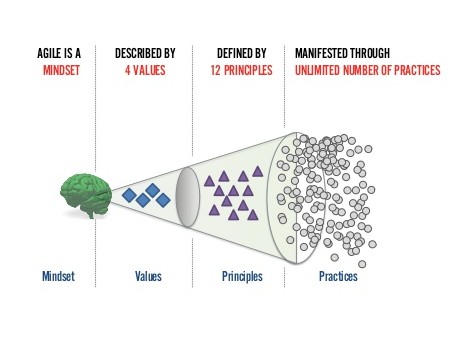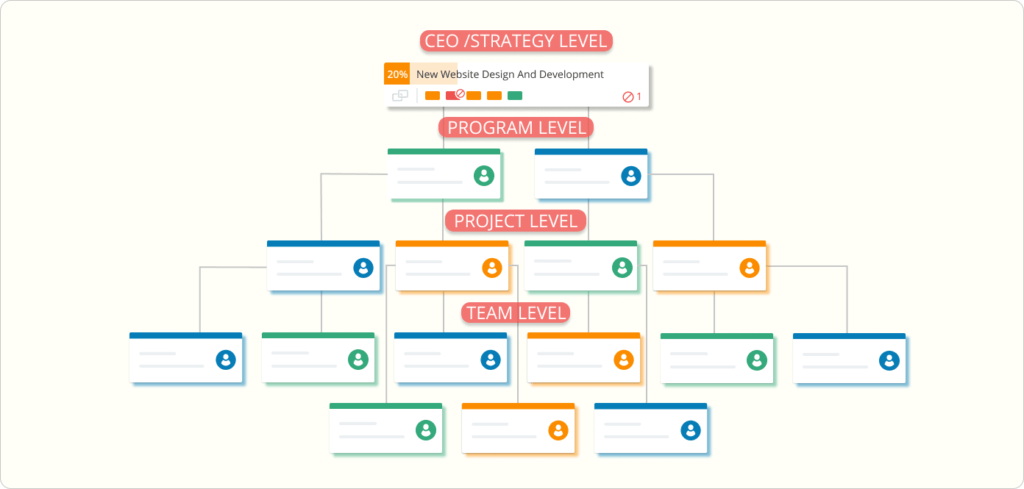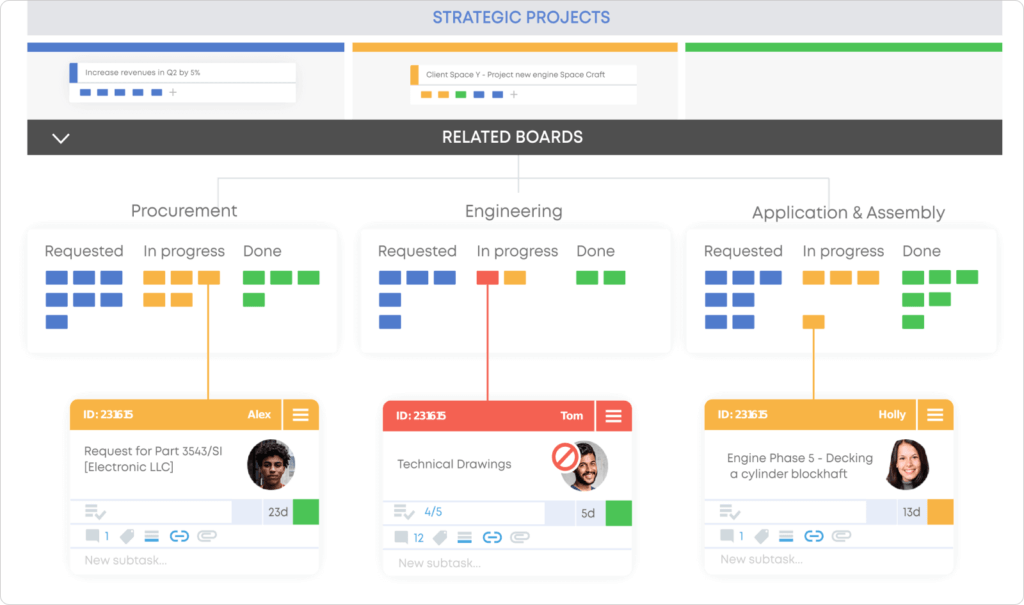In Businessmap, we're die-hard fans of efficiency and continuous improvement. And this doesn't necessarily mean implementing Agile practices by the book.
In our experience, we've seen companies that try so hard to embrace all of the "best Agile practices" on their transformation journey but still lack something to get the desirable results.
I am sure they don't implement Agile just because it's a buzzword, so what are they really looking to accomplish?
Usually, the answer is:
- faster delivery
- higher customer satisfaction
- better adaptability to changes, etc.
But you can't expect to achieve these things by blindly following the "best Agile practices" out there. That's because every business environment is different.
So, what should you do?
Agile vs. Agility: Understanding the Difference
A quick search on the internet will reveal some of the biggest misunderstandings about Agile, for example:
- Agile is a methodology;
- it's for software development;
- it works only for individual teams.
In fact, Agile is a mindset represented by 4 values and 12 principles and manifested through various practices. Having said that, there is no way a mindset can be only applicable to a given industry or part of an organization.
 The Agile mindset: image by Ahmed Sidky
The Agile mindset: image by Ahmed Sidky
Unfortunately, this is where many companies get it wrong. Some of them don't embrace the Agile mindset but its practices first. Doing this prevents them from understanding the logic behind "why Agile", which creates results only in one part of the chain and leads to imbalance.
For example, if an organization's goal is to deliver features faster, they might roll out Scrum across development teams. However, if the marketing team is busy launching feature A while feature B is already live, it doesn't matter how fast the development was.
This is where the difference between Agile and agility lies.
Agility is the state of being (not just doing) Agile, which means going beyond its "well-known" practices. It requires you to understand that there's always room for improvement to tailor your products/services to today's dynamic business environment.
It's also about recognizing that the Agile mindset can be instilled across the entire organization and building symbiosis between its separate parts. Agility represents true adaptability, so when you pull one lever at the top of the organizational ship, all of its constituting parts start moving in the right direction.
Think Global, Act Local
A lot of the Agile transformation failures are related to applying Agile only locally.
While that's the way to go initially, many organizations stop there without realizing that, in reality, their company represents a network of complex systems. This means that changes to one part will have an effect on another.
After all, according to Deming:
"94% of problems in organizations are systems-driven, and only 6% are driven by other special causes."
W. Edward Deming. Source: Deming.org
This leads the conversation to systems thinking, where true organizational agility lies. While you can start implementing the Agile mindset and its practices locally, the results will also be stationed locally. That's why, to achieve nimbleness and respond to changes faster, aim to gradually spread them horizontally and vertically across the organization.

The idea is to create connected systems, optimize the whole, and find the unique needs of these systems in terms of satisfying customer expectations (internal or external). This might require the application of Kanban, Scrum, XP, only stand-ups and visualization, or maybe even something unrelated to Agile practices.
The goal is achieving agility and adaptability to changes instead of just implementing a bunch of best Agile practices because it is trendy.
How to Embrace Agility in Practice?
Moving forward, we will give you some directions that can help you step foot on the path of true agility. Let's list them below.
Focus on the Culture
"It's a culture thing". I am sure you've heard that before.
The culture in a company is the most important thing when looking to adopt Agile, Lean, new technology, or anything else.
Many examples of Agile companies start their transformational journey without a clear vision. In turn, this results in a lack of shared purpose and misalignment between different organizational structures. In other words, everybody is doing what they feel is best for themselves.
But as we alluded to above, this is a recipe for achieving local results, not global. That's why, if you are a leader, make sure you properly communicate the need for adopting Agile. To do that, you can:
- Organize training on grasping the logic behind Agile, not only the specific practices you're looking to implement.
- Work together with teams to carve out a shared vision for the Agile implementation.
- Listen to their problems, and practice servant leadership to make people feel like valuable assets, not expendable resources in the organization.
The idea is to create an environment where people feel engaged, valued, and part of something big. This makes sense from a social psychology perspective but can be the subject of a whole new book, so let's move on.
Evolution over Revolution
In other words, "Start with what you do now".
Often, companies are quick enough to roll out a given Agile method or framework and expect to achieve results overnight. However, this big-bang approach usually creates resistance which is likely to result in more negatives than positives.
Not to mention this approach is very risky because if a particular Agile method or practice worked in one situation, it might not be universally applicable.
That's why, before implementing anything, understand your current systems and their delivery capabilities. See where the problems lie and evolve what you currently have.
This approach mitigates the risk of failure and allows you to analyze what improvements you really need. As a result, you can mix the Agile practices based on your organization's needs instead of relying on a single framework to be a "one-size-fits-all" solution.
Identify Value Streams
First, you should recognize that your organization is a network of interconnected services and systems. Every service (marketing, sales, IT) produces a result that contributes to the final customer value delivery.
 Image credit: Kanban Maturity Model (KMM), Second Edition
Image credit: Kanban Maturity Model (KMM), Second Edition
Then, look to visualize your existing services, so you can understand how they are dependent on one another. This will allow you to identify the value streams in your organization and uncover their problems. The goal is to start improving entire value streams so they become flexible to handle changing business priorities or emerging issues.

Pursue Continuous Improvement
The key to success, not just in Agile but many other things, lies precisely here.
We say that "There is always a better way". And that refers to agility as well. There isn't a single recipe for success here.
To achieve true agility, I believe you need to follow the principle of "Shu-Ha-Ri". Start by learning the rules and adopting the mindset behind them (Shu), gradually detach from the rules (Ha), find new ways of doing things from your own practice (Ri).
In Agile, it's the same. Learn the practices and fit them to your situation, but don't stop there. Experiment with other ways of working too (even if some are not purely Agile but apply to your scenario), collect feedback and take action.
Keep experimenting, adapting, and continuously improving. This is the true definition of agility.
Focus on Agility to Achieve True Adaptability
At the end of the day, agility is concerned with understanding, adopting, and progressively evolving the Agile ways of working. This enables companies to be more adaptive and resilient when dealing with complexity and uncertainty.
After all, this is the true goal behind any Agile transformation.
Just beware of slipping into the state of doing Agile without being Agile. That's a dangerous place to be in when talking about agility!

Nikolay Tsonev
Product Marketing | PMI Agile | SAFe Agilist certified
Nick is a seasoned product marketer and subject matter expert at Businessmap, specializing in OKRs, strategy execution, and Lean management. Passionate about continuous improvement, he has authored numerous resources on modern-day management. As a certified PMI practitioner and SAFe Agilist, Nick frequently shares his insights at Lean/Agile conferences and management forums.



